
Introduction to Upcycling Ideas for Clothes
Upcycling is a creative and sustainable approach to fashion that involves repurposing old clothing items into new and unique pieces. This eco-friendly practice not only reduces waste but also allows individuals to express their creativity through do-it-yourself (DIY) projects. With the growing concern about environmental impact, upcycling old clothes has gained popularity as an innovative and stylish trend in the fashion industry.
Repurposing Men’s Shirts
When it comes to upcycling old clothes, men’s shirts are a versatile and abundant resource. With a little creativity and some basic sewing skills, you can transform these shirts into stylish and unique pieces for yourself or your loved ones. One excellent project to start with is repurposing a men’s shirt into an adorable child’s dress. Here’s a step-by-step guide to help you get started:
1. Choose the Right Shirt
Look for a men’s shirt that has a fun pattern or color that will work well for a child’s dress. You can also consider using oversized shirts for an extra flowy and comfortable look.
2. Prepare the Shirt
Start by washing and ironing the shirt to ensure it is clean and wrinkle-free. This will make the sewing process much easier.
3. Measure and Cut
Lay the shirt flat on a table or cutting mat and measure the desired length of the dress. Use fabric scissors to cut across the shirt, just above where you want the hemline to be. Remember to leave some extra fabric for seam allowance.
4. Create Armholes
Fold the shirt in half vertically, matching up the shoulder seams. At about 1-2 inches from the top, mark where you want the armholes to be on both sides of the folded shirt. Then, use your scissors to carefully cut out these marked areas.
5. Sew the Side Seams
Unfold the shirt and lay it flat again, right side facing up. Pin along both sides of the shirt, aligning the edges, including the armhole openings. Use a sewing machine or hand stitch along these pinned edges, making sure to backstitch at the beginning and end to secure your stitches.
6. Finish Hemming
Fold up about ¼ inch of fabric along the bottom edge of the dress and press it with an iron. Then, fold it up again, this time about 1 inch, to create a clean and finished hemline. Pin in place and sew along the folded edge.
7. Add Finishing Touches
To make the dress even more special, consider adding some decorative elements like buttons, bows, or pockets. These small details can elevate the overall look of the dress and make it truly unique.
By repurposing a men’s shirt into a child’s dress, you not only give new life to old clothing but also create something special for a little one to enjoy. So, dig into your closet or visit a thrift store to find the perfect shirt for your upcycling project.
Summer Top Ideas for Upcycling Men’s Shirts
When it comes to upcycling men’s shirts, the possibilities are endless. After transforming a men’s shirt into an adorable child’s dress, you can repurpose the remaining fabric to create stylish summer tops. Here are some creative ideas for repurposing men’s shirts into fashionable summer tops:
- Off-shoulder blouse: Cut off the collar and sleeves of the shirt to create an off-shoulder look. Add elastic to the top edge for a comfortable and trendy fit.
- Tie-front crop top: Use the bottom hem of the shirt to tie a knot at the front, creating a stylish crop top perfect for summertime.
- Ruffle sleeve blouse: Utilize the shirt sleeves to add ruffle details to a basic blouse, giving it a feminine and playful touch.
- Button-up tank top: Transform the front portion of the shirt into a button-up tank top by removing excess fabric and sewing new seams for a fitted silhouette.
The versatility of men’s shirts allows for various design options when creating summer tops. By upcycling old shirts, you not only reduce waste but also add unique pieces to your wardrobe that reflect your creativity and style.
2. Upcycling Jeans
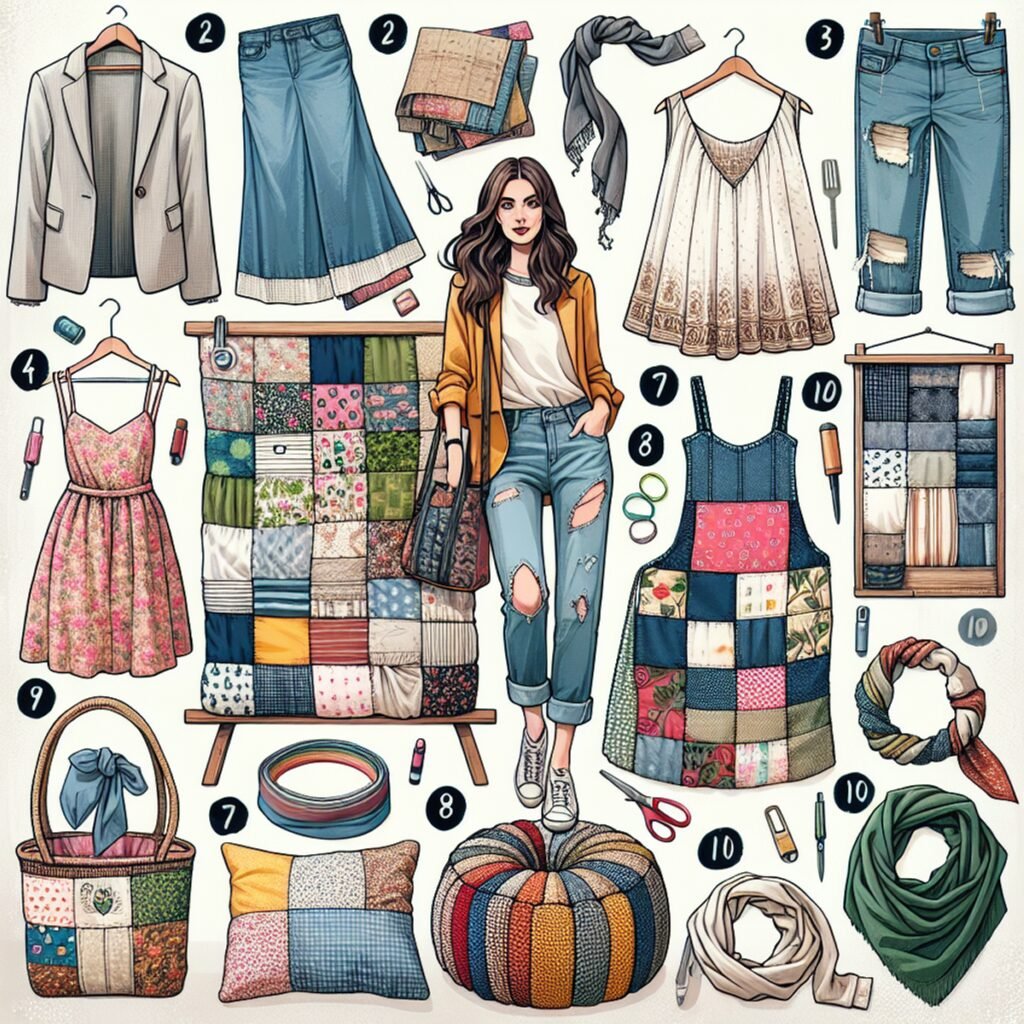
There are numerous creative ways to upcycle old jeans and turn them into fashionable and functional items. Whether your denim jeans no longer fit or they’re worn out, upcycling them can give the fabric a fresh start and help reduce waste.
Skirts
Making stylish skirts out of denim is a popular upcycling project that lets you highlight the unique texture and durability of jeans. Here are some techniques for creating fashionable skirts from old jeans:
- Patchwork Skirts: Piecing together different denim patches from old jeans can result in a unique and eclectic patchwork skirt. By arranging the patches in creative ways, like those showcased in this DIY patched denim round-up, you can add visual interest and personality to the garment.
- Denim Fringe Skirts: Adding fringe to the hem of a denim skirt can give it a bohemian and playful vibe. By carefully cutting the hem and unraveling the threads, you can create a fringed edge that adds movement and texture to the skirt.
- A-line or Flared Skirts: By repurposing the legs of old jeans, you can create A-line or flared skirts that offer a classic and versatile look. Depending on the original style of the jeans, you can modify the silhouette to suit your preferences.
- Distressed Denim Skirts: Embracing the distressed look of denim, you can strategically distress and fray sections of the jeans to create a trendy and edgy denim skirt. This upcycled denim Marie Antoinette post on Reddit showcases how you can create unique distressed denim designs.
Upcycling jeans into skirts not only extends the lifespan of the fabric but also allows you to express your personal style through custom designs and embellishments.
By exploring these techniques, you can give new life to old jeans while reducing waste and contributing to sustainable fashion practices. Each method offers a unique way to transform denim into stylish skirts, allowing you to showcase your creativity and passion for upcycling clothing.
Handbags
When it comes to upcycling jeans, the possibilities are endless. One fantastic way to repurpose old denim is by transforming it into trendy handbags. Handbags made from upcycled jeans not only look stylish but also contribute to sustainable fashion practices.
Step-by-step Guide
Here’s a simple guide to creating your own denim handbag through upcycling:
- Gather Materials: Collect an old pair of jeans, scissors, sewing machine or needle and thread, fabric for lining, and any embellishments you want to add.
- Cut the Jeans: Carefully cut the legs off the jeans and then cut along the inner seam to open them up.
- Create Bag Shape: Use a template or an existing bag to trace and cut out the shape from the denim fabric.
- Sew the Bag: Sew the sides and bottom of the bag together, then attach the lining and any additional pockets or closures.
- Add Straps and Embellishments: Attach denim straps or repurpose leather belts as handles. You can also add decorative elements like patches or embroidery for a personalized touch.
By following these steps, you can turn old jeans into a fashionable and eco-friendly handbag that complements your style while reducing textile waste.
Wall Hangings: Using Old Jeans for Versatile Upcycled Creations
When it comes to upcycling jeans, there are countless creative ways to repurpose denim into unique and eye-catching wall hangings. Here are some innovative ideas for turning old jeans into distinctive wall decorations:
- Patchwork Masterpieces: Cut out different patches of denim from old jeans and sew them together to create a visually stunning patchwork wall hanging. You can play with different shades of denim to add depth and texture to the piece.
- Embroidered Designs: Use embroidery techniques to embellish sections of denim, adding intricate patterns or colorful motifs. The contrast between the rugged denim fabric and delicate embroidery creates a striking visual impact.
- Denim Tapestries: Combine strips of denim in varying lengths and widths to craft a captivating tapestry-like wall hanging. Experiment with different weaving patterns and textures to achieve a one-of-a-kind piece of art.
- Upcycled Pocket Organizers: Repurpose the pockets from old jeans by attaching them to a fabric backing to create a functional yet stylish wall organizer. The pockets can be used to store small items while adding an interesting design element to the space.
Upcycling jeans into wall hangings not only gives new life to discarded denim but also adds a touch of character and personality to any room. Get creative with your old jeans and transform them into captivating pieces of art for your walls.
3. Repurposing Old T-shirts
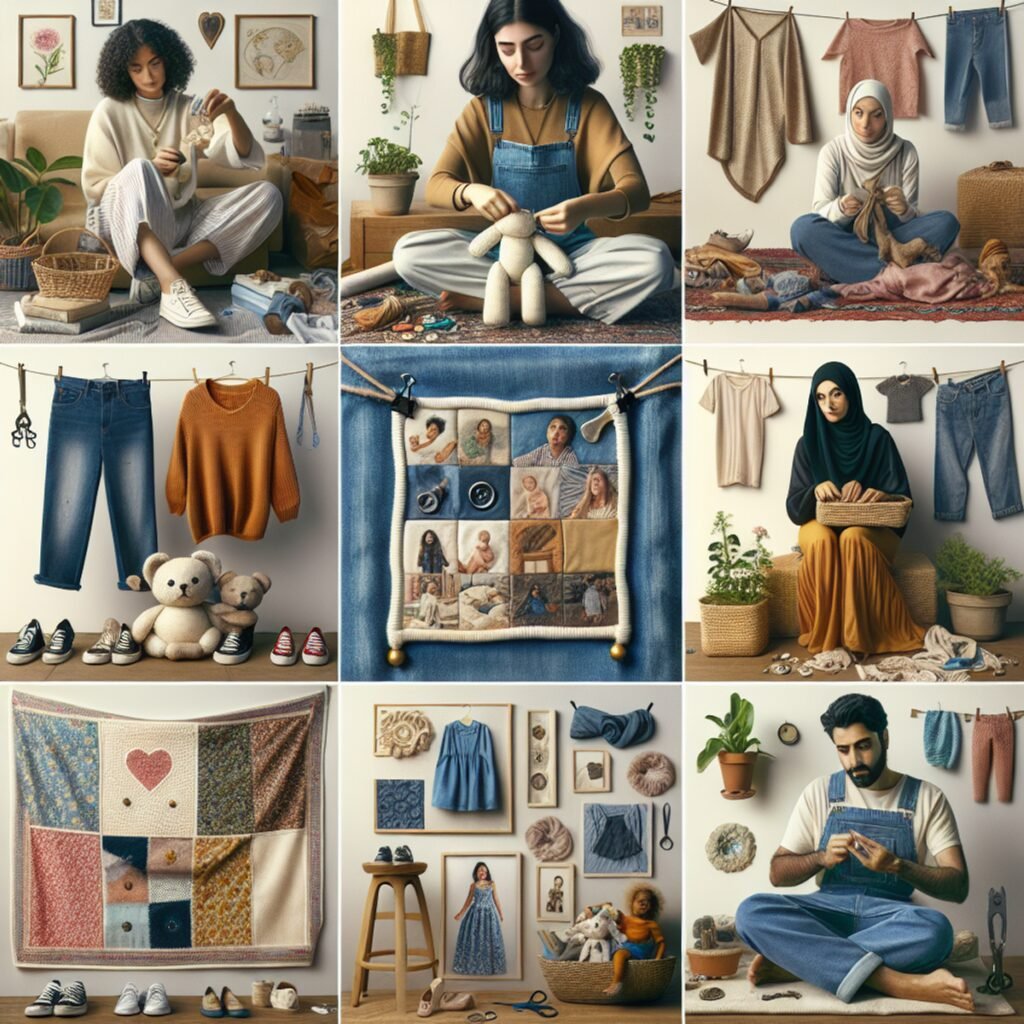
When it comes to upcycling old clothes, T-shirts are a versatile item that can be transformed into various new pieces. Here are some creative ideas for repurposing old T-shirts:
Child Leggings
One popular DIY project is transforming T-shirts into comfortable leggings for kids. This is a great way to extend the life of your child’s favorite T-shirts and create unique and cozy clothing items. Here’s how you can do it:
- Choose a T-shirt: Select a T-shirt that your child has outgrown or one that has a stain or tear but still has a usable fabric.
- Prepare the T-shirt: Lay the T-shirt flat on a cutting mat or table. Smooth out any wrinkles to ensure accurate cutting.
- Measure and mark: Measure your child’s legs and add a few inches to allow for seam allowances and stretch. Mark these measurements on the T-shirt using tailor’s chalk or fabric marker.
- Cut the fabric: Use sharp fabric scissors to cut along the marked lines, creating two identical leg pieces.
- Sew the leggings: With right sides together, stitch along the inseam of each leg using a sewing machine or hand stitching. If you don’t have sewing skills or equipment, you can use fabric glue or iron-on hem tape as an alternative.
- Create the waistband: Fold over the top edge of the leggings about one inch and stitch around, leaving a small opening to insert elastic.
- Insert elastic: Cut a piece of elastic according to your child’s waist measurement minus one inch for comfort. Attach a safety pin to one end of the elastic and thread it through the waistband casing. Stitch the ends of the elastic together and sew up the opening in the waistband.
- Finish the leggings: Hem the bottom edges of the leggings by folding them over twice and stitching in place. Trim any loose threads and give the leggings a final press.
By repurposing old T-shirts into child leggings, you not only save money but also create unique and comfortable clothing for your little ones. It’s a fun and rewarding project that allows you to showcase your creativity while reducing textile waste.
Bags and Rag Rugs
Repurposing old T-shirts offers a world of creative possibilities in the realm of upcycling projects. Here are some innovative ideas for breathing new life into worn-out T-shirts:
1. Stylish Bags
Transform adult T-shirts into fashionable and functional bags. By cutting, sewing, and accessorizing, you can create unique tote bags, crossbody bags, or even backpacks. The colorful patterns and textures of the T-shirt fabric can add a playful and eclectic touch to your bag designs.
2. Cozy Rag Rugs
Embrace the cozy charm of rag rugs made from repurposed T-shirts. Cut the fabric into strips and weave or crochet them into soft and durable rugs for your home. These rag rugs not only add a cozy aesthetic to your living space but also contribute to sustainable decor by utilizing old clothing in a practical way.
These upcycling projects allow you to infuse your personal style into everyday items while reducing clothing waste and environmental impact. The versatility of T-shirt fabric opens up endless opportunities for crafting one-of-a-kind accessories and home decor pieces.
4. Upcycling Sweaters/Jumpers
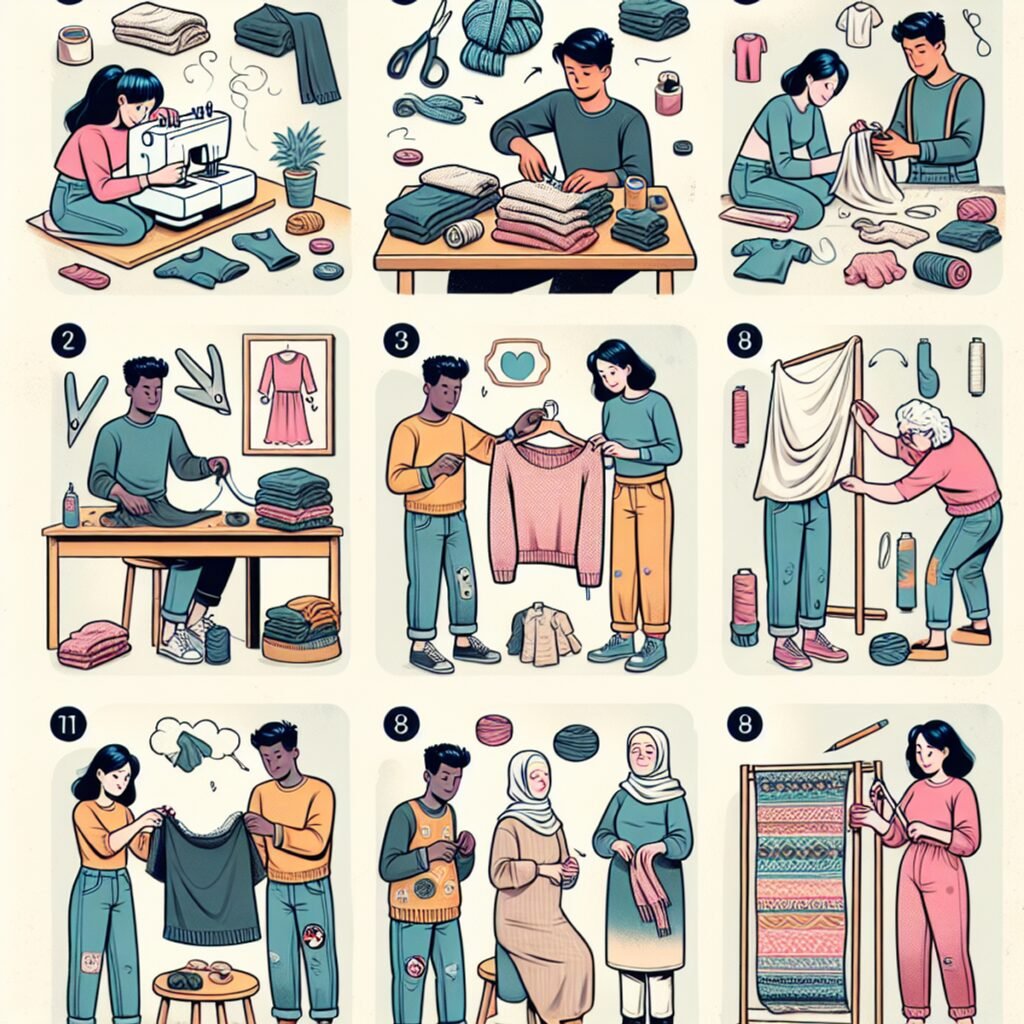
When it comes to upcycling old sweaters and jumpers, there are plenty of creative ways to give them a new lease on life. One popular option is transforming them into cozy mittens. Here’s a step-by-step guide to help you get started:
- Gather Your Materials: You’ll need an old sweater or jumper, fabric scissors, tailor’s chalk or a marker, pins, sewing needle, and thread.
- Create a Mitten Template: Place your hand on the sweater with the thumb extended and trace around it, leaving a little extra space for seam allowance. Cut two of these shapes for each mitten.
- Pin and Sew: Place the pieces together with the right sides facing inwards and pin them together. Then, carefully sew along the traced lines, leaving the bottom open.
- Trim Excess Fabric: Trim any excess fabric and turn the mittens inside out.
- Finishing Touches: Fold the cuffs to your desired length and stitch them in place for a neat finish.
This upcycling project not only breathes new life into old sweaters but also provides you with a unique and cozy pair of mittens for the colder months.
Remember, upcycling is all about creativity and innovation, so don’t be afraid to experiment with different sweater textures, patterns, and colors to make your mittens truly one-of-a-kind!
By giving old sweaters and jumpers a second chance as stylish accessories like mittens, you’re not only reducing waste but also adding a personal touch to your wardrobe. Upcycling is a sustainable and rewarding way to embrace creativity while making a positive impact on the environment.
Fingerless Gloves
When it comes to upcycling sweaters/jumpers, fingerless gloves are another brilliant idea that combines warmth and style. Fingerless gloves allow you to keep your hands cozy while still having the freedom to use your fingers. Here’s how you can upcycle your old sweaters/jumpers into fashionable fingerless gloves:
- Gather your materials: Choose a sweater/jumper that you no longer wear but still love the fabric and texture of. You’ll also need a pair of scissors, sewing pins, and a sewing machine or needle and thread.
- Measure and cut: Start by measuring the length of your hand from the base of your palm to just below your knuckles. Use this measurement to mark the length on the sleeve of the sweater/jumper. Cut along the marked line, creating two equal pieces for each glove.
- Fold and pin: Take one of the cut pieces and fold it in half with the right sides facing each other. Pin along the raw edges, leaving a small opening at the base for your thumb.
- Sew or hand stitch: Using a sewing machine or needle and thread, sew along the pinned edges, leaving the thumb opening unstitched. If you’re hand stitching, you can refer to this hand-sew felt tutorial for some useful tips.
- Repeat for the second glove: Repeat steps 3 and 4 for the second cut piece of sweater/jumper.
- Trim and finish: Trim any excess fabric and turn the gloves right side out through the thumb opening. Adjust them to fit comfortably on your hands.
Now you have a stylish pair of fingerless gloves that not only keep you warm but also give your old sweaters/jumpers a new lease on life. These gloves are perfect for chilly days when you need some extra coziness without sacrificing functionality.
By upcycling sweaters/jumpers into fingerless gloves, you’re reducing waste and creating unique accessories that reflect your personal style. So, dig into your wardrobe and find those old sweaters/jumpers that are ready for a transformation into fashionable fingerless gloves. If you’re looking for inspiration or patterns, websites like Glove.org and Icelandic Knitter have a wide range of modern and trendy glove designs that you can explore. Additionally, if you want to enhance your sewing experience with the right tools, don’t forget to check out this useful guide on finding the best thimble to make your stitching process easier and more efficient.
5. Creative Ideas for Fabric Scraps
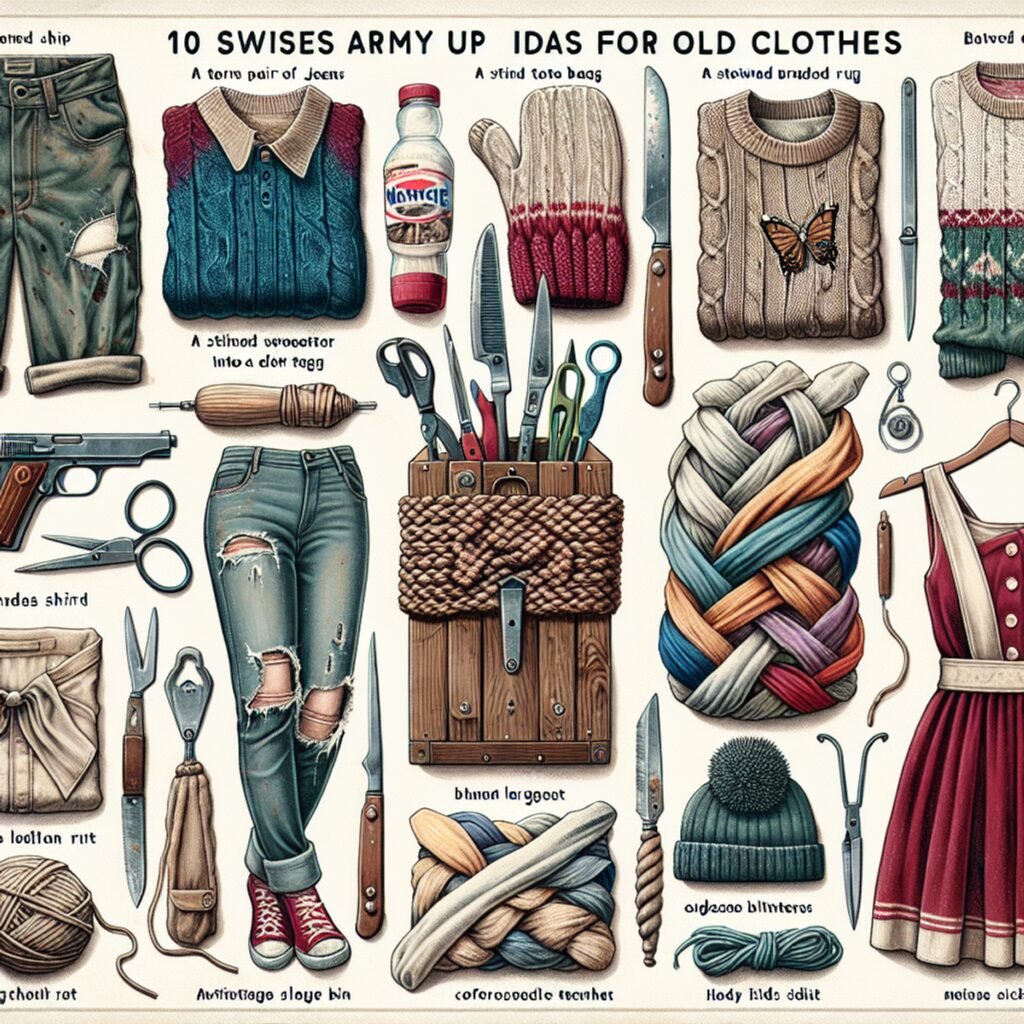
When it comes to upcycling, fabric scraps are a treasure trove of possibilities. Instead of throwing them away, you can transform these small remnants into functional and beautiful items for your home. Here are some creative ideas for repurposing fabric scraps into useful household cloths:
Household Cloths
- Patchwork Dishcloths: Make colorful and unique dishcloths by sewing together different fabric scraps in a patchwork design. These cloths not only add a touch of personality to your kitchen but also help reduce waste by using up leftover fabric.
- Reusable Wipes: Cut fabric scraps into squares or rectangles and use them as reusable wipes for cleaning surfaces, dusting, or even as baby wipes. You can sew two layers of fabric together or simply serge the edges to prevent fraying.
- Napkins: Create stylish cloth napkins by cutting larger fabric scraps into square or rectangular shapes. These eco-friendly napkins are not only great for everyday use but also perfect for special occasions when you want to impress your guests with your sustainable choices.
- Unpaper Towels: Ditch disposable paper towels and make your own reusable alternatives using fabric scraps. Cut the scraps into rectangular shapes, attach snaps or Velcro to the corners, and roll them up on a paper towel holder for easy dispensing.
- Quilted Coasters: Combine small fabric scraps with batting or felt to create quilted coasters that protect your table surfaces from hot drinks. Experiment with different color combinations and stitching patterns to add a personalized touch.
- Pot Holders: Use thicker fabric scraps, such as old denim or canvas, to make heat-resistant pot holders. Layer the fabric with insulating material like batting or heat-resistant lining and sew around the edges for added durability.
- Tea Towels: Turn fabric scraps into charming tea towels by hemming the edges and adding decorative trims or embroidery. These homemade tea towels are not only functional but also make lovely gifts for friends and family.
Remember, the possibilities are endless when it comes to upcycling fabric scraps. Don’t be afraid to get creative and mix different patterns and textures to make your household cloths truly unique. By repurposing fabric scraps, you not only reduce waste but also add a personal touch to your home.
So, before you toss those fabric scraps into the trash, think about how you can give them a new life as useful household cloths. Get your sewing machine ready and start transforming those small remnants into functional and eco-friendly items for your home.
Face Masks
Making use of leftover fabrics in various upcycled projects, face masks are a practical and stylish way to repurpose fabric scraps. With the increasing need for face masks in today’s world, creating your own unique masks can be both eco-friendly and cost-effective. Here are some talking points to guide you through the process:
- Colorful fabric selection: Choose vibrant and patterned fabric scraps to add a touch of personality to your face masks. Look for fabrics that are breathable and comfortable to wear.
- Cutting and measuring: Use a template or an existing face mask as a guide to cut out fabric pieces from your scraps. Ensure that you have enough fabric for both the front and back layers of the mask.
- Layering and sewing: Place the front and back layers of the fabric together, with the patterned sides facing each other. Sew along the edges, leaving a small opening for turning the mask right side out.
- Elastic or tie options: Decide whether you want to use elastic ear loops or fabric ties for securing the mask. Elastic can be sewn into the sides of the mask, while fabric ties can be attached to each corner of the mask.
- Finishing touches: Once you have secured the elastic or ties, sew up the small opening used for turning the mask right side out. You can also add a nose wire or filter pocket if desired.
Remember to wash your fabric scraps before using them for face masks and follow recommended guidelines for wearing and caring for cloth masks. By upcycling fabric scraps into face masks, you not only reduce waste but also contribute to sustainable living while keeping yourself protected.
Bunting
Making use of leftover fabrics in various upcycled projects is a great way to reduce waste and get creative. One fun and festive idea is to create upcycled fabric scrap bunting. This colorful decoration can add a whimsical touch to any space, whether it’s for a party or simply to liven up your home.
Why Choose Upcycled Fabric Scrap Bunting?
Here are some reasons why upcycled fabric scrap bunting is a great choice for adding a festive touch:
- Repurposing fabric scraps: Instead of throwing away small pieces of fabric, you can repurpose them into something beautiful and useful. Bunting is a perfect project for utilizing these leftover materials.
- Easy DIY project: Creating fabric scrap bunting is a simple and enjoyable DIY project that doesn’t require advanced sewing skills. It’s a great option for beginners or those looking for a quick and rewarding craft.
- Versatile decoration: Upcycled fabric scrap bunting can be used in various settings and occasions. Whether you want to decorate your garden for a summer BBQ, add flair to a child’s bedroom, or create a festive atmosphere for a celebration, bunting is an excellent choice.
- Customizable design: Fabric scrap bunting allows you to incorporate different colors, patterns, and textures into your design. You can mix and match fabric scraps from various projects or use specific themes to fit the occasion.
- Sustainable alternative: By choosing to make your own bunting using fabric scraps, you are reducing the need for new materials and minimizing waste. It’s an eco-friendly way to decorate and contribute to sustainable living.
How to Make Fabric Scrap Bunting
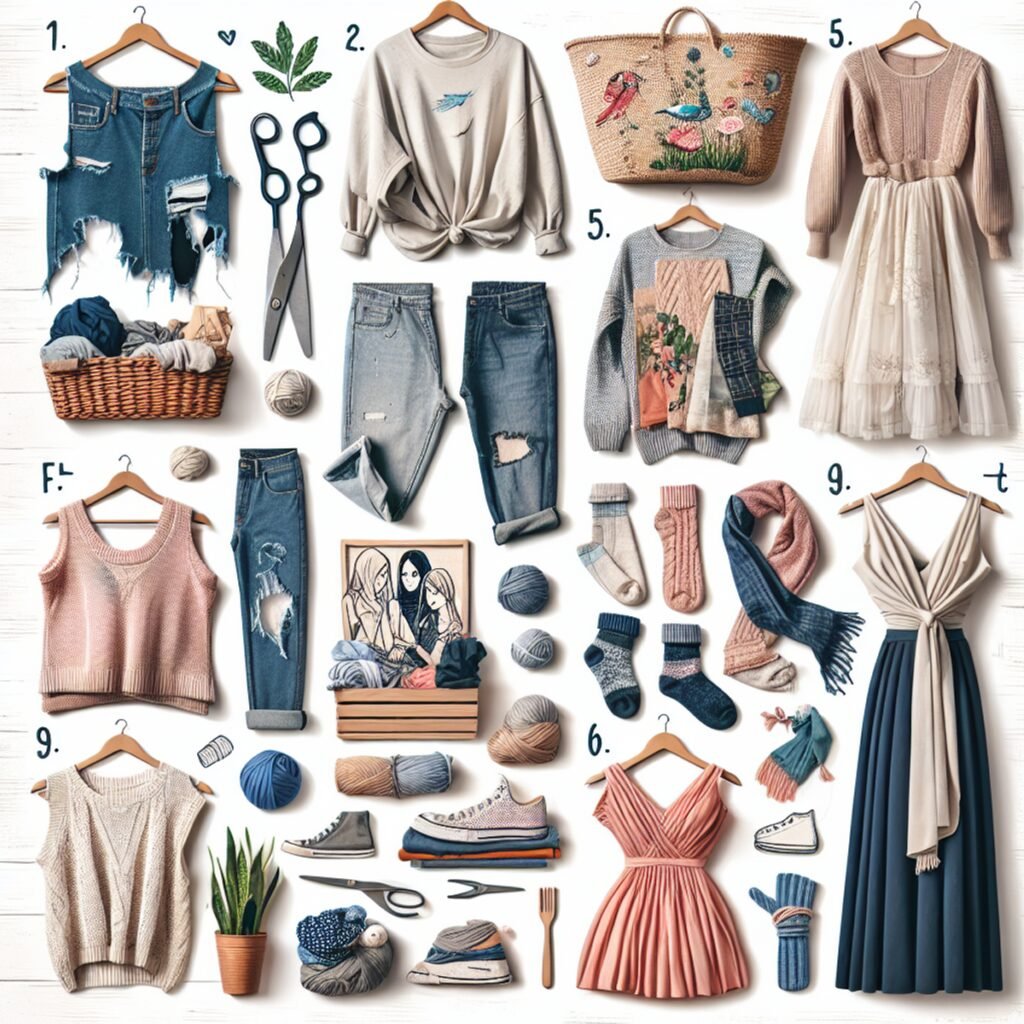
To create fabric scrap bunting, you will need some basic supplies like fabric scraps, scissors, twine or ribbon, and a sewing machine or needle and thread. Follow these steps:
- Cut out triangles from the fabric scraps, leaving extra at the top for attaching them to the twine or ribbon.
- Sew or glue the triangles onto the twine, evenly spacing them apart.
Pro tip: If you don’t have a sewing machine or prefer a no-sew option, you can use fabric glue or iron-on adhesive tape to attach the triangles.
Get Creative with Fabric Scrap Bunting
With fabric scrap bunting, you can transform leftover fabrics into a charming decoration that adds personality and color to any space. So why not give it a try and let your creativity shine?
Conclusion
Now that you’ve discovered these brilliant upcycling ideas for clothes, it’s time to get creative and make a positive impact on the environment and your wardrobe.
By upcycling old clothes, you can:
- Reduce waste
- Save money
- Create unique and stylish pieces that reflect your personal style
Whether you’re transforming men’s shirts into adorable dresses for children or turning old sweaters into cozy mittens, there are endless possibilities for repurposing and reinventing your wardrobe.
Embrace the DIY spirit and follow the step-by-step guides provided to bring these ideas to life.
Not only will you have fun in the process, but you’ll also contribute to a more sustainable fashion industry.
So why wait? Start exploring these upcycling ideas today and let your creativity soar. Remember, every small step counts in creating a more eco-friendly world. Happy upcycling!
FAQs (Frequently Asked Questions)
What is upcycling and its role in sustainable fashion?
Upcycling is the process of transforming old or unwanted materials into something new and useful, with the aim of reducing waste. In the context of fashion, upcycling plays a crucial role in sustainable fashion by promoting the reuse of clothing items, which helps minimize the environmental impact of the fashion industry.
Why is upcycling old clothes popular as a DIY trend?
Upcycling old clothes has gained popularity as a DIY trend because it allows individuals to express their creativity while contributing to environmental sustainability. It provides an opportunity to give new life to old garments, creating unique and personalized pieces without the need for purchasing new clothing.
How can I transform a men’s shirt into a child’s dress?
You can transform a men’s shirt into a child’s dress by following a step-by-step guide that outlines the process. This creative upcycling project allows you to repurpose the shirt fabric into an adorable and stylish dress for children.
What are some creative ideas for repurposing men’s shirts into summer tops?
Repurposing men’s shirts into stylish summer tops offers versatility and uniqueness. By exploring creative ideas, you can transform old shirts into fashionable tops suitable for the warm weather, adding a personal touch to your wardrobe.
How can I repurpose old T-shirts into child leggings?
Repurposing old T-shirts into child leggings involves a DIY project that guides you through the transformation process. This allows you to create comfortable and practical leggings for kids using worn-out T-shirts.
What are some innovative ways to turn jeans into unique wall decorations?
You can explore innovative techniques to turn old jeans into unique wall hangings, adding a decorative element to your living space. This upcycling project allows you to repurpose denim in creative ways, contributing to sustainable decor solutions.







2 thoughts on “10 Brilliant Upcycling Ideas for Clothes You Need to Try Today”